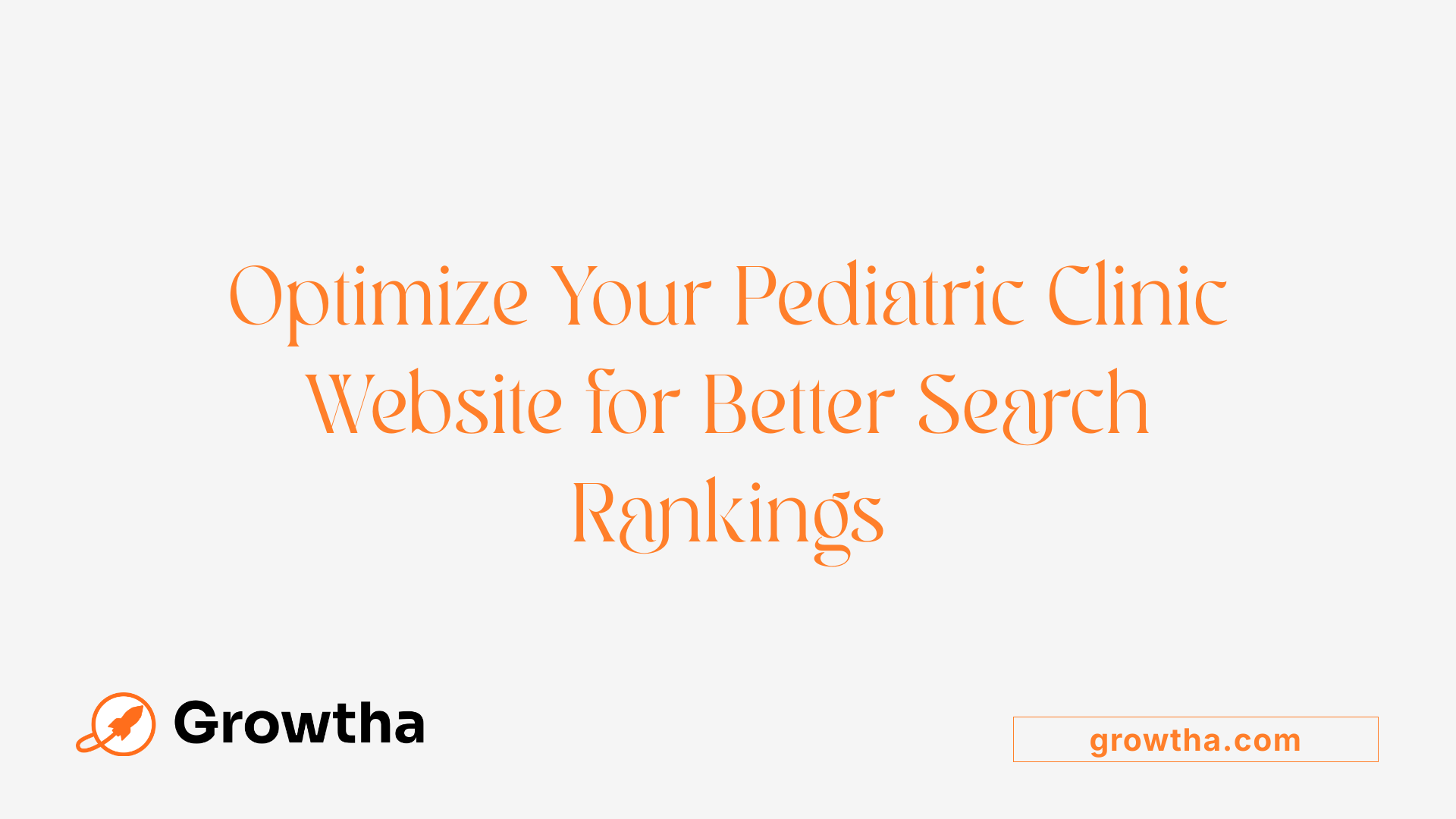SEO Strategies for Pediatric Therapy Clinics
Unlocking Growth: Effective SEO Techniques for Pediatric Therapy Centers


SEO Strategies for Pediatric Therapy Clinics
The Power of SEO in Growing Pediatric Therapy Practices
In the competitive landscape of pediatric therapy, establishing a strong online presence is essential for attracting new patients and building community trust. Search Engine Optimization (SEO) offers a cost-effective, sustainable strategy to enhance visibility, improve search rankings, and position your practice as a trusted leader in children's healthcare. This comprehensive guide explores proven SEO strategies tailored specifically for pediatric therapy clinics, covering everything from local optimizations to content marketing, website design, and reputation management.
Understanding the Importance of SEO for Pediatric Therapy Clinics

Why SEO is crucial for increasing online visibility
For pediatric therapy clinics, standing out in a crowded healthcare market is vital. Search Engine Optimization (SEO) plays a central role in elevating a clinic's online presence. When families search for pediatric services online, they are likely to click on the top results on Google or other search engines. If your practice appears higher in these search results, more potential patients will find you. This increased visibility leads to higher appointment bookings and helps grow your practice.
A well-optimized website, with relevant keywords and local SEO strategies, helps clinics appear in local search results. For example, parents searching for 'pediatrician near me' or 'pediatric occupational therapy' are more likely to find your clinic if you have optimized your online profiles and content.
How targeted search strategies attract local families
Local SEO is especially important because it targets families in your immediate area. By optimizing your Google My Business profile, including accurate location information, and gathering positive reviews, your practice becomes more visible when parents search for nearby pediatric services.
Using keywords related to your specific services, such as 'feeding therapy for children' or 'speech therapy near me,' ensures that your practice shows up in relevant searches. Creating content around common concerns and questions of local parents — like blog posts or FAQ sections — can also improve your ranking and position your practice as an authority.
The long-term benefits of effective SEO
Investing in SEO doesn’t just bring short-term gains. A strong, sustainable SEO strategy can keep your practice visible online for years. It builds credibility and trust through high-quality content, positive reviews, and reputable backlinks.
Moreover, SEO is cost-effective compared to traditional advertising. Once your website ranks well, it continues to attract organic traffic without ongoing ad spend. Regular updates and ongoing optimization make sure your practice stays competitive amid changing search trends.
By embracing these strategies, your pediatric therapy clinic can establish a robust online presence that attracts local families consistently, ensuring long-term growth and community trust.
Core Components of SEO in Pediatric Healthcare

What are effective SEO strategies for pediatric therapy clinics?
Optimizing website content with relevant keywords is fundamental for pediatric therapy clinics seeking higher search rankings. This includes incorporating local terms, such as "pediatric occupational therapy near me," and healthcare-specific phrases that potential patients are searching for. Ensuring the website is mobile-friendly—meaning it adapts seamlessly to smartphones and tablets—and loads quickly offers a smooth user experience, aligns with search engine preferences, and keeps visitors engaged.
Maintaining accurate online directory listings and managing Google My Business profiles is crucial for local visibility. Encouraging satisfied patients to leave reviews can boost credibility and help clinics appear more prominently in local search results. Developing high-quality content, like blogs, videos, and FAQs, positions clinics as authorities in pediatric healthcare, which can attract organic traffic.
Building backlinks from reputable health websites, leveraging social media channels, and regularly analyzing website performance through tools like Google Analytics are also vital strategies. Together, these efforts create a robust SEO ecosystem that helps attract new patients and builds long-term trust.
How can clinics utilize keyword research tools effectively?
Tools such as Google Keyword Planner, SEMrush, and Ahrefs are invaluable for identifying relevant, high-impact keywords. Clinics should seek out keywords with high search volume but low competition, like "speech therapy for children" or "pediatric occupational therapy in [City]." Incorporating these keywords naturally into website content — in titles, headings, meta descriptions, and blog posts — improves visibility in search engine results.
Regularly reviewing keyword performance with these tools allows clinics to refine their content strategies. For example, if certain keywords perform well, they can be emphasized further, or new related terms can be explored to capture emerging search trends. This ongoing process helps maintain relevance and competitiveness in local healthcare markets.
Designing a Website that Ranks Well

What website design considerations are important for optimizing search rankings in pediatric therapy clinics?
Creating an effective website for a pediatric therapy clinic involves several crucial design aspects that directly influence its search engine ranking and attract more local patients.
First, a clear and logical site structure is fundamental. Descriptive URLs, organized content, and straightforward navigation help search engines easily crawl and index the site. Including relevant keywords naturally in titles, headers, and URL slugs ensures the content aligns with what prospective parents are searching for.
Mobile optimization is a top priority. Most parents search for healthcare services on smartphones, so the website must be mobile-friendly. This includes responsive design features that adapt seamlessly to different screen sizes and resolutions, providing a smooth user experience.
Page load speed is another vital factor. Fast-loading pages reduce bounce rates and improve rankings. Techniques such as compressing images, leveraging browser caching, and minimizing code help keep load times low.
Content quality and keyword integration are equally important. High-quality, authoritative, and regularly updated content tailored to the target audience not only educates visitors but also signals relevance to search engines. On-page SEO elements, such as optimized titles, meta descriptions, header tags, and alt text for images, make the site more understandable and accessible to Google.
Internal linking and a well-structured navigation hierarchy facilitate user engagement and help search engines discover new content easily. Technical SEO elements like schema markup, SSL certificates, and clean code boost overall site performance and security.
Finally, tools like Google Search Console can monitor how well the website performs in search results. Adding media content like videos and infographics enriches the user experience, making the site more engaging and shareable.
By focusing on these design principles, pediatric therapy clinics can significantly improve their online visibility, attract new patients, and stand out in local search results.
Optimizing Local Visibility for Community Reach

What local SEO tactics can pediatric therapy clinics use to improve their visibility?
For pediatric therapy clinics aiming to serve their local community effectively, a strategic approach to local SEO is essential. One of the most effective methods is optimizing their Google My Business (GMB) profile. This involves keeping all information accurate, up-to-date, and complete, including hours of operation, services offered, and contact details. High-quality photos and encouraging satisfied patients to leave positive reviews can significantly boost the clinic’s appeal on local searches.
Creating location-specific landing pages is another vital tactic. These pages should feature unique content tailored to each community served, including relevant keywords and schema markup, which helps search engines understand and rank the pages better. Incorporating local keywords naturally into website content, meta descriptions, headers, and service pages increases the chances of appearing in searches like “pediatric therapist near me” or “children’s occupational therapy in [City].”
Building backlinks from reputable local sources such as community health directories, local news outlets, and partner organizations can also enhance the clinic’s authority and ranking. Ensuring consistency in NAP (Name, Address, Phone number) information across all online platforms and directories strengthens trust and relevance in local searches.
Beyond technical optimizations, actively engaging with the community via content — such as health tips, success stories, and local events — fosters relationships and credibility. Responding promptly to reviews and questions on platforms like Google and social media sites enhances reputation and demonstrates responsiveness. Collectively, these tactics improve visibility, attract nearby families needing pediatric services, and help clinics grow their presence in the community.
Content Marketing and Patient Engagement Strategies

How can pediatric therapy clinics effectively use content marketing to attract patients?
Pediatric therapy clinics can significantly enhance their visibility and reputation through targeted content marketing. Creating reliable, informative content tailored to the concerns of parents and caregivers is essential. This includes developing blog posts, videos, and success stories that showcase therapy techniques, patient progress, and the overall benefits of the clinic’s services.
A well-planned strategy begins with understanding the target audience—parents seeking specialized pediatric care—and conducting content audits to identify relevant topics. Using SEO best practices ensures that content ranks well on search engines, making it easier for potential patients to find the clinic.
Educational content such as FAQs, expert interviews, and webinars not only builds trust but also positions the clinic as an authority in pediatric therapy. Sharing resources through the clinic’s website, social media platforms, and email campaigns helps increase engagement and maintain ongoing relationships.
It's crucial that all content emphasizes accuracy, empathy, and confidentiality. Citing reputable sources like HealthyChildren.org and adhering to HIPAA regulations reassures parents of the credibility and safety of the information. Multimedia content, including videos, virtual tours, and live Q&A sessions, enhances understanding and fosters a more personal connection.
By consistently providing valuable, accessible information, pediatric clinics can attract more families, improve patient satisfaction, and establish a reputation as a caring, knowledgeable provider—leading to long-term growth and community trust.
Tracking Performance and Maintaining SEO Success
How can pediatric therapy clinics monitor and improve their SEO efforts?
To effectively track and enhance their SEO strategies, pediatric therapy clinics should utilize powerful analytics tools such as Google Analytics and Google Search Console. These platforms provide valuable insights into website traffic, user engagement, conversion rates, and keyword performance. By regularly reviewing this data, clinics can determine which content resonates most with visitors and identify areas that need adjustments.
One essential aspect is updating existing website content to remain current and relevant to patient needs. Fresh, informative blog posts and service pages not only improve user experience but also boost search engine rankings.
Building a strong backlink profile is another vital component. Clinics can seek backlinks from reputable sources like health organizations, local directories, and community websites, which enhance their site’s authority.
Staying compliant with healthcare regulations, especially HIPAA, is crucial during these activities. This ensures patient privacy is maintained, even as SEO practices such as online reviews and content marketing are implemented.
Continuously refining SEO strategies based on insights gained from analytics, industry updates, and evolving consumer search behaviors guarantees sustained visibility. These ongoing efforts help attract more local patients, improve online reputation, and maintain a competitive edge in the pediatric healthcare market.
Strategic Steps Toward Digital Excellence in Pediatric Therapy
Implementing a comprehensive SEO strategy tailored for pediatric therapy practices is vital for standing out in a competitive healthcare market. By focusing on local SEO, website optimization, content marketing, and reputation management, clinics can significantly improve their online visibility and attract targeted patient populations. Continuous monitoring using analytics tools, staying compliant with industry standards, and evolving with search engine algorithms are essential. With these concerted efforts, pediatric therapy clinics can establish a robust digital footprint, foster trust among parents, and achieve sustained growth in their practice.
References
- Pediatric SEO - Patient Care Marketing Pros
- Essential SEO Techniques to Grow Your Pediatric Practice
- How to Market Your Pediatric Therapy Clinic - Practice Promotions
- The Ultimate Guide to SEO for Speech Therapists
- SEO for Therapists: 10 Steps to Rank Higher and Get More Patients
- Physical Therapy SEO: A Comprehensive Guide - PtEverywhere
- 5 Proven SEO Tweaks That Transformed Our OT Client Referrals
- SEO For Therapists In 2024: A Comprehensive Guide - Therapy Flow







